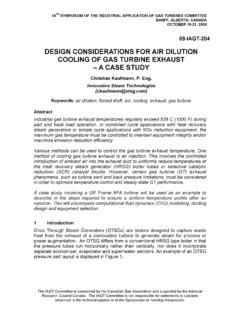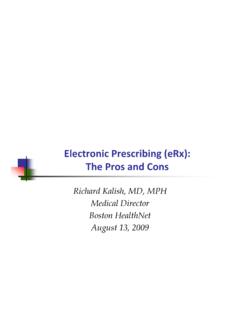Transcription of Pros and Cons - Airflow Sciences
1 pros and Consof CFD and Physical Flow Modeling A White Paper by: Kevin W. Linfield, , Robert G. Mudry, August, 2008 2008 Airflow Sciences Corporation All Rights Reserved In a CFD model, the three-dimensional domain is built in the computer via a CAD model. A computational mesh is then inserted into the domain this mesh divides the region where flow travels into many control volumes, or cells. It is not uncommon for a CFD model to contain millions of these cells. The software then solves the equations of fluid motion (Conservation of Mass, Momentum, and Energy) in every one of these cells. The results are plotted as color contours to depict the flow parameters at any location within the domain.
2 Thus, it is possible to analyze millions of velocities, pressures, temperatures, species concentrations, and other values. Computer-generated animations can also be created that provide flow visualization to observe the real-time motion of the 2 - CFD mesh for an electro-static precipitator Computational Fluid Dynamics (CFD) is a method of simulating fluid flow behavior using high speed computers. There are well-known mathematical equations that define how air and gases behave (Conservation of Mass, Momentum, and Energy). These equations are extremely complex (differential equations), and thus can not be solved by hand calculations except for very simple geometries such as flow around a cylinder.
3 As computer power increased in the 1970s, the aerospace industry led the way in developing software to approximate solutions to these equations for complicated flows around air and space craft. Over the past few decades, these software tools have advanced to a point where accurate solutions can be obtained for complex flows, including heat transfer, particle tracking, and chemical it comes to flow modeling to optimize performance or to develop solutions for flow-related problems, a frequent question that industry engineers ask is Which is better a CFD or physical (scale) flow model? . The short answer is It Depends .Figure 1 CFD was first developed for the aerospace industryNASAB ackground Once the physical model is constructed, large fans are used to draw air through the model at a flow rate that provides similar fluid dynamic behavior to the full scale system.
4 Flow characteristics are measured over a grid of traverse points with an inserted probe. Values for velocity and pressure at select locations are thus obtained. Dust can be injected into a model to simulate the behavior of particulate in a system (to assess ash deposition, for example). Of course, the model is constructed with clear walls or windows so that flow patterns can be observed via smoke flow, strings, or bubbles. Model results can be presented as color contours, histograms, or other plotting methods similar to field testing. It is difficult to determine how long physical flow modeling has been used in engineering applications. Obviously, full-scale versions of land and sea vessels were tested via trial-and-error for centuries to optimize designs.
5 In the early 1900s, the Wright Brothers tested a scaled version of an airfoil in a small wind tunnel that led to the age of flight. Since the 1960s, scale models have been used to assess flow patterns in power plant duct systems, pollution control equipment, and boilers. Today, many of these models are built to a scale of 1:8 to 1:16, with 1:12 being a common scale factor. With either type of model, the flow patterns through the system are quantified and the model geometry is iteratively altered in order to optimize the flow. The location and shape of control devices such as turning vanes, mixers, baffles, and dampers are thus determined such that the design objectives are 5. Smoke flow through an SCR physical modelFigure 3.
6 Wright Brother s wind tunnelFigure 4. Physical flow model of a power plant dry scrubber and baghouse systemAccuracy With the proliferation of high speed computers, the resolution and cell size of CFD models has improved dramatically over the past few decades. Airflow Sciences Corporation, which has used both modeling methods since 1975, has made numerous comparisons between CFD modeling, physical modeling, and field testing. Results indicate that both types of models share the same accuracy when it comes to velocities and pressures. For more on this please visit ASC s web site ( ) for Conference Proceedings which make this comparison with respect to ESP and scrubber modeling.
7 There are certain areas where CFD and physical model results differ and it is not clear which provides the best real-world results. For instance, in SCR modeling, CFD models tend to predict slightly worse ammonia uniformity at the catalyst compared to physical models. Industry comfort is with the physical model in this case, and it is possible that the underlying mesh is not fine enough to resolve all the details of the injection and mixing. That said, there is not a lot of specific data published that shows how well either model matches real-world test data. Similarly, for wet FGD absorbers and stacks, physical models are often used with liquid water injected into the models. Though the droplet size is not scaled properly, and evaporation is not represented accurately, some industry designers find value in the results and utilize their experience to interpret the results of the wet modeling.
8 This is a very complex flow phenomenon, where two-phase flow momentum effects the droplet agglomeration exist. This is equally difficult to simulate with a CFD model, even with evaporation and thermal effects simulated. So both model types have drawbacks and industry experience in applying the results to the real world become important. CFD model studies are generally 20-40% less than a comparable physical model effort. This is tied quite strongly to the labor difference in model construction that influences the schedule. Also, many CFD tasks can be automated with the computer, including the design optimization process, whereas these tasks are primarily manual with the physical model.
9 Most physical models are built to scale, typically 1:12 or 1:16 for power plant models. CFD models are almost always built full size (1:1 scale). Care must be taken in computer models to ensure that the correct number, size, and shape of computational cells are used, and the level of detail to include must be considered in a scaled model to ensure geometric and dynamic similarity is maintained. In a CFD model, the Reynolds Number is often matched exactly, while in a physical model industry generally tries to match the Reynolds Number regime ( , laminar or turbulent). Both are fine as long as the boundary layer is negligible. This is generally the case for large power plant duct systems.
10 Note, however, that one must closely match the exact value of the Reynolds Number if the objective is to determine lift or drag characteristics, or any system where the boundary layer along a surface is important. Figure 7. Comparison of CFD and physical model of a windbox CFD modeling is almost always faster than physical modeling. In many cases, design results from a CFD model are available several weeks before similar results from a scale model. And the more complicated or repetitive the model geometry is, the more advantage the CFD model has. This has to do with three factors: 1) the CFD mesh can usually be built faster than a scale model can be fabricated, 2) for repetitive or symmetric duct systems, portions of a CFD model can be copied and pasted while all pieces of the physical model need to be built separately, and 3) once a CFD model is built, it can be run simultaneously on separate computers.










